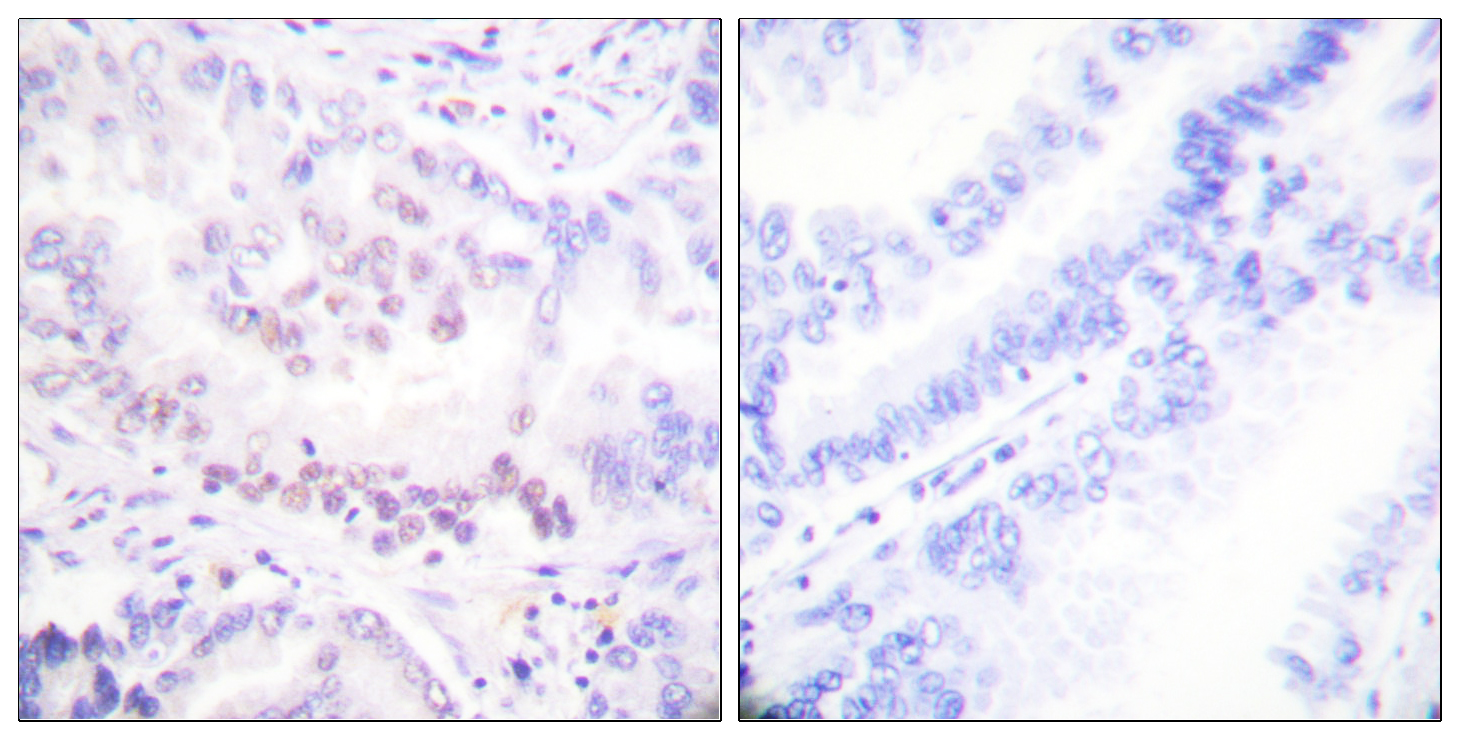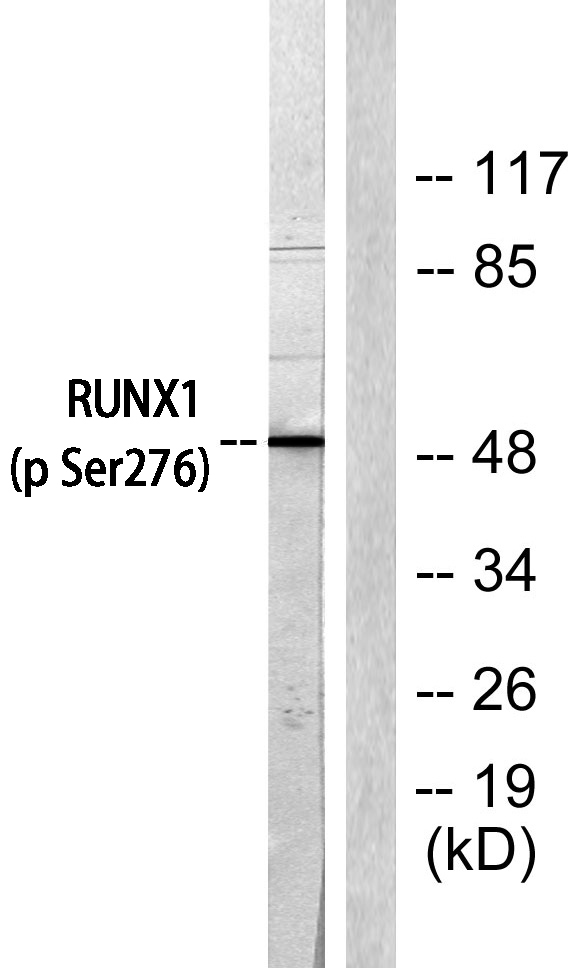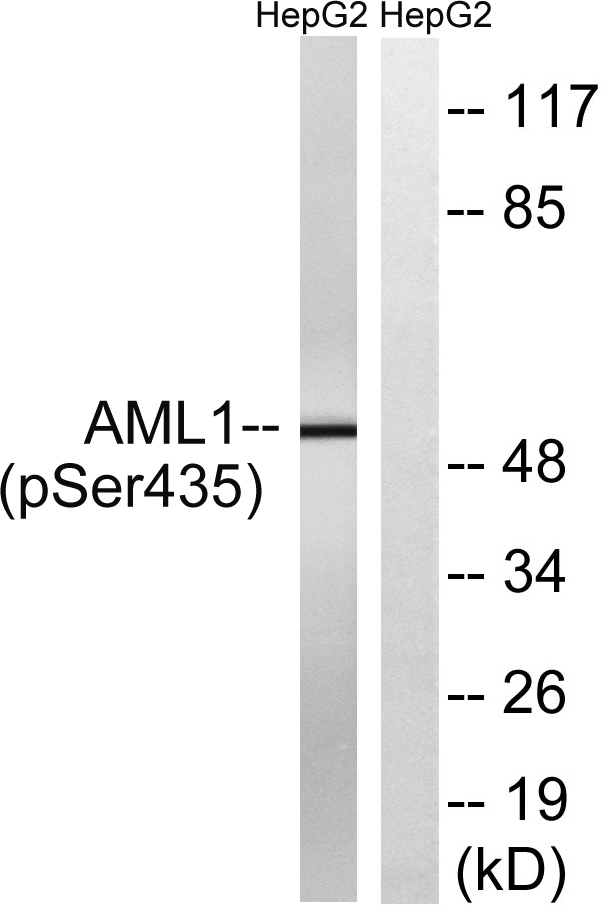RUNX1 (phospho Ser276) Polyclonal Antibody
- Catalog No.:YP0622
- Applications:WB;IHC;IF;ELISA
- Reactivity:Human;Mouse;Rat
- Target:
- RUNX1
- Fields:
- >>Tight junction;>>Th17 cell differentiation;>>Pathways in cancer;>>Transcriptional misregulation in cancer;>>Chronic myeloid leukemia;>>Acute myeloid leukemia
- Gene Name:
- RUNX1
- Protein Name:
- Runt-related transcription factor 1
- Human Gene Id:
- 861
- Human Swiss Prot No:
- Q01196
- Mouse Gene Id:
- 12394
- Mouse Swiss Prot No:
- Q03347
- Rat Gene Id:
- 50662
- Rat Swiss Prot No:
- Q63046
- Immunogen:
- The antiserum was produced against synthesized peptide derived from human AML1 around the phosphorylation site of Ser303. AA range:269-318
- Specificity:
- Phospho-RUNX1 (S276) Polyclonal Antibody detects endogenous levels of RUNX1 protein only when phosphorylated at S276.
- Formulation:
- Liquid in PBS containing 50% glycerol, 0.5% BSA and 0.02% sodium azide.
- Source:
- Polyclonal, Rabbit,IgG
- Dilution:
- WB 1:500 - 1:2000. IHC 1:100 - 1:300. ELISA: 1:5000.. IF 1:50-200
- Purification:
- The antibody was affinity-purified from rabbit antiserum by affinity-chromatography using epitope-specific immunogen.
- Concentration:
- 1 mg/ml
- Storage Stability:
- -15°C to -25°C/1 year(Do not lower than -25°C)
- Other Name:
- RUNX1;AML1;CBFA2;Runt-related transcription factor 1;Acute myeloid leukemia 1 protein;Core-binding factor subunit alpha-2;CBF-alpha-2;Oncogene AML-1;Polyomavirus enhancer-binding protein 2 alpha B subunit;PEA2-alpha B;PEBP2-alpha
- Observed Band(KD):
- 55kD
- Background:
- Core binding factor (CBF) is a heterodimeric transcription factor that binds to the core element of many enhancers and promoters. The protein encoded by this gene represents the alpha subunit of CBF and is thought to be involved in the development of normal hematopoiesis. Chromosomal translocations involving this gene are well-documented and have been associated with several types of leukemia. Three transcript variants encoding different isoforms have been found for this gene. [provided by RefSeq, Jul 2008],
- Function:
- alternative products:Additional isoforms seem to exist,caution:The fusion of AML1 with EAP in T-MDS induces a change of reading frame in the latter resulting in 17 AA unrelated to those of EAP.,disease:A chromosomal aberration involving RUNX1/AML1 is a cause of chronic myelogenous leukemia (CML). Translocation t(3;21)(q26;q22) with EAP, MSD1 or EVI1.,disease:A chromosomal aberration involving RUNX1/AML1 is a cause of chronic myelomonocytic leukemia. Inversion inv(21)(q21;q22) with USP16.,disease:A chromosomal aberration involving RUNX1/AML1 is a cause of M2 type acute myeloid leukemia (AML-M2). Translocation t(8;21)(q22;q22) with RUNX1T1/MTG8/ETO.,disease:A chromosomal aberration involving RUNX1/AML1 is a cause of therapy-related myelodysplastic syndrome (T-MDS). Translocation t(3;21)(q26;q22) with EAP, MSD1 or EVI1.,disease:A chromosomal aberration involving RUNX1/AML1 is found in child
- Subcellular Location:
- Nucleus.
- Expression:
- Expressed in all tissues examined except brain and heart. Highest levels in thymus, bone marrow and peripheral blood.
- June 19-2018
- WESTERN IMMUNOBLOTTING PROTOCOL
- June 19-2018
- IMMUNOHISTOCHEMISTRY-PARAFFIN PROTOCOL
- June 19-2018
- IMMUNOFLUORESCENCE PROTOCOL
- September 08-2020
- FLOW-CYTOMEYRT-PROTOCOL
- May 20-2022
- Cell-Based ELISA│解您多样本WB检测之困扰
- July 13-2018
- CELL-BASED-ELISA-PROTOCOL-FOR-ACETYL-PROTEIN
- July 13-2018
- CELL-BASED-ELISA-PROTOCOL-FOR-PHOSPHO-PROTEIN
- July 13-2018
- Antibody-FAQs
- Products Images

- Enzyme-Linked Immunosorbent Assay (Phospho-ELISA) for Immunogen Phosphopeptide (Phospho-left) and Non-Phosphopeptide (Phospho-right), using AML1 (Phospho-Ser303) Antibody

- Immunohistochemistry analysis of paraffin-embedded human lung carcinoma, using AML1 (Phospho-Ser303) Antibody. The picture on the right is blocked with the phospho peptide.

- Western blot analysis of lysates from Jurkat cells, using AML1 (Phospho-Ser303) Antibody. The lane on the right is blocked with the phospho peptide.


